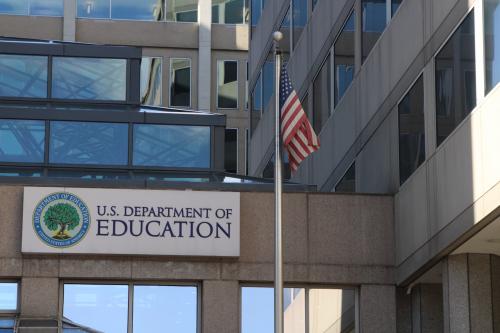The proliferation of civil wars over the past decade has produced a growing number of humanitarian emergencies that require international attention. As the world’s only superpower and a major humanitarian aid donor, the United States has a critical role in shaping the response to these emergencies. Whether or not the Bush administration decides to maintain American leadership in this area, it will have to develop firm guidelines for humanitarian action in the cases it chooses to address. It should remedy four major failings in the U.S. government response to prior humanitarian emergencies:
- Inadequate protection of the physical safety and human rights of the affected populations
- Insufficient focus on internally displaced persons as compared with refugees
- The absence of robust institutional mechanisms to coordinate the many disparate offices of the U.S. government working on humanitarian and human rights emergencies
- Inadequate attention to deficiencies in the international response system
POLICY BRIEF #83
What’s Missing: A Policy Foundation
Despite his stated wariness about engaging in humanitarian disasters, human rights crises, and peace operations abroad, President Bush will face a number of such emergencies during his presidency. When confronted with such events, his administration will need to balance America’s traditional global leadership in this arena, the nation’s long and short-term strategic interests, and the costs and benefits of intervention, often in the face of rapidly evolving events.
In particular, the Bush administration should consider the dramatic changes that have taken place internationally in confronting situations of mass starvation, mass killings, or genocide which have become broadly accepted triggers for international action. Sovereignty is no longer an unbreachable barrier when large numbers of people are at risk. International interventions in Iraq, Somalia, Bosnia, Haiti, Kosovo, and East Timor all make clear that sovereignty can be overridden when governments fail to protect their populations.
The Bush administration would benefit from a policy review to formulate guidelines, particularly a set of criteria to guide its decisions on the level of U.S. engagement during humanitarian and human rights emergencies. The guidelines should address those circumstances where measured U.S. investments early in a crisis might prevent it from expanding into one requiring large-scale U.S. military intervention and should examine when gross violations of human rights will prompt a U.S. response; whether the crisis poses a threat to international peace and security; the consequences of inaction; and available resources.
Continued reliance on ad hoc criteria for determining if and when the United States might respond will have costs, most notably in time-consuming debate each time a crisis arises, policy inconsistency, and delayed action. It will also confuse U.S. allies and may embolden the adversaries America is trying to contain.
To make the interventions it chooses to join more effective, and to improve the impact of humanitarian actions undertaken by international organizations, the Bush administration should address the following problems.
The Protection Gap
Providing food, medicine, and shelter is often useless in emergency situations unless those receiving the aid are protected against assault, human rights abuse, and ongoing warfare. Sudan, Africa’s largest nation, which has suffered civil war almost unabated since 1983, offers a prime example of the failure of humanitarian assistance when unaccompanied by measures for protection and conflict resolution. Over the past ten years, the United States has delivered up to $1 billion in relief aid to the Sudan. But the food, medicines, and seeds, while helpful, have not protected the Dinka, Nuba, and other tribes from a devastating array of assaults.
In the Balkans, Bosnian Muslims experienced the same problem. “We prefer to be hungry for a week than not to sleep every night, in fear of being beaten, raped, or killed,” several Muslims told the UN High Commissioner for Refugees (UNHCR). Likewise, beleaguered Kurds, Chechens, Sierra Leoneans, and Colombians have made clear that the provision of food and supplies must be combined with efforts to protect their physical safety and human rights.
The U.S. government provides large-scale material assistance in international emergencies and maintains an extensive system of reporting on human rights abuses, but it is singularly ill-prepared in the area of actual protection of crisis victims, except in the limited cases where military forces are deployed. No locus of responsibility exists within the civilian side of the U.S. government to ensure that crisis victims escape major assault. The Field Operations Guide of the Office of U.S. Foreign Disaster Assistance, an arm of USAID, even stipulates that U.S. assessment and disaster assistance response teams “should not assume any responsibility” for protecting uprooted persons. The State Department’s Bureau of Democracy, Human Rights, and Labor, while undertaking advocacy with governments that violate human rights, does not itself address how to protect people on the ground.
At the international level, the institutional arrangements supported by the United States often perpetuate the same gap. UN assessment teams sent out in emergencies routinely include expertise in food aid, water supply, health, sanitation, and shelter, but rarely in how to deal with the human rights and physical safety of the affected population. The UN resident/humanitarian coordinators deployed on the ground to manage the international response often have little experience or training in protection, and even designated lead agencies in particular operations are unfamiliar with protection issues. In Angola, the World Food Programme was designated lead agency despite massive protection problems. The lack of attention to protecting persons caught up in the civil war in Angola was exposed only after Richard Holbrooke, the U.S. Ambassador to the UN, visited that country in 1999.
America provides support to UNHCR, the International Committee of the Red Cross (ICRC), and various non-governmental organizations (NGOs), which do undertake protection activities. But these agencies are not present in all emergencies and even when they are, their presence may be small. There is no current consensus on an international division of labor for protection. Nor is there an experienced or well-trained reserve corps of protection specialists that can be activated in emergencies to help evacuate people, create protected areas, establish a presence near people in danger, defuse tensions, monitor returns home, and mobilize international support. Units for such a corps could be drawn from humanitarian and human rights organizations, constabulary and police forces, and security specialists.
Reconfiguring U.S. government agencies and programs toward a combination of relief assistance and protection programs is essential. Assignment of responsibility within the State Department and/or USAID for designing and implementing grassroots protection programs, while encouraging UN and NGO protection activities, is key to making U.S. humanitarian assistance more relevant to today’s emergencies. An added benefit to developing civilian capacity would be to create a viable alternative to reliance on military forces, which would be used only when armed power is absolutely essential.
Neglect of Internally Displaced Persons
The civil wars, ethnic strife, and massive human rights violations that lead to humanitarian and human rights emergencies generally produce mass displacement on both sides of the border. But only refugees?those who flee persecution across borders?can predictably expect to receive material aid and protection from the international community. Those who remain forcibly displaced within their own countries?internally displaced persons (IDPs)?have no effective international system like UNHCR to turn to, even though they may be in more desperate straits. The international protection system set up for refugees after World War II provided help only to those who managed to cross the border into a foreign state. Persons uprooted and persecuted in their own countries were considered the responsibility of their own governments, even when those governments subjected them to deliberate starvation, mass killings, or genocide.
It was not until the last decade of the twentieth century that a sense of international responsibility began to emerge toward internally displaced persons. One reason was their growing numbers. When they were first counted in 1982, there were 1.2 million IDPs in 11 countries. By 1997, with the spread of civil wars in Africa and the break-up of the Soviet Union, 20 to 25 million IDPs were to be found in 40 countries. Today, there are far more internally displaced persons than refugees. In Africa alone, there are more than 10 million IDPs but only 3.5 million refugees.
The internally displaced also came to the fore because of growing acceptance of the idea that events taking place within a country should be a legitimate concern of the international community. By 1990, the UN launched an international effort in the Sudan to bring food and supplies to IDPs. During crises in Iraq, Somalia, Bosnia, and Rwanda, the Security Council authorized the use of force to bring relief and, in some cases, protection to IDPs.
Still, IDPs continue to receive second-class treatment in most emergencies. After the 1994 genocide in Rwanda, most aid went to those who fled to Zaire, with those uprooted inside Rwanda largely left to fend for themselves. In Kosovo, the lion’s share of international aid went to the 900,000 ethnic Albanians forced out of the province, whereas the hundreds of thousands forcibly displaced inside remained basically unaided and unprotected until the war was over. International policies and structures that continue to focus on only one side of the border will assure that large numbers of IDPs receive little or no help.
There is no coherent approach to IDPs within the U.S. government. There is currently no office with clear responsibility for these populations, even though they are the majority of today’s emergency victims, and not a single U.S. government employee devotes the majority of his or her time to internal displacement issues. In some instances, IDPs fall under the State Department’s Bureau of Population, Refugees, and Migration (PRM), although the office mostly deals with refugee protection. In other instances, IDPs fall under the aegis of USAID, an agency with little experience or authority in the areas of protection or human rights concerns. More often than not, they fall between the bureaucratic cracks.
Even when officials from these offices do want to advocate for greater IDP protection, they often find themselves without adequate influence in the policymaking process. An internal government report issued in 2000 that was compiled by the State Department and USAID found that humanitarian personnel were often excluded from the political deliberations affecting their work. This became especially clear during the Kosovo crisis, when military and political strategists failed to anticipate the massive refugee flows that resulted from their policies, and no adequate contingency plans for refugees or IDPs were developed.
Ineffective Coordination
High-ranking State Department and Pentagon officials who were preoccupied a decade ago with the threats presented by the Soviet Union are more likely today to be managing “contingency operations” arising from humanitarian crises. Increasing globalization has also been driving traditionally domestic departments toward involvement in foreign crises. Yet there is no coordinating mechanism that systematically links the National Security Council (NSC), the Department of State, Defense Department, USAID, and other government agencies that make policy or provide relief and development assistance during humanitarian emergencies.
In the massive 1998 Hurricane Mitch disaster in Central America, for example, during which the U.S. government spent more than one quarter of a billion dollars on relief efforts and deployed more than 5,000 civilian and military personnel to the region, federal relief efforts were duplicative, laden with confused mandates, and unnecessarily costly for taxpayers. In crises like Bosnia and Kosovo, coordination problems within the U.S. government proliferated among civilian agencies and between civilian agencies and regional military commands. State Department diplomatic efforts, Defense Department security concerns, USAID foreign aid programs, and Justice Department law enforcement issues all bumped up against one another, often amid marginally successful attempts at coordination by the National Security Council.
Clinton administration efforts to coordinate responsibilities never fully took hold. In order for the Bush administration to deliver effective programs during crises, it must develop a more integrated system.
An Inadequate International Response System
At the international level, sustained U.S. attention is also needed to influence the shaping of a more effective humanitarian response in emergency situations. The United States provides significant funding to UN agencies and bears responsibility for ensuring that those agencies do their jobs properly.
Yet the international response system is largely ad hoc. The humanitarian, human rights, and development organizations that become involved pick and choose the situations in which they wish to become engaged on the basis of their mandates and resources. UNHCR generally limits its interventions to refugees and to certain categories of IDPs. UNICEF does not become involved with all categories of affected children. The World Food Programme and the UN Development Program rarely tackle protection issues directly. ICRC becomes involved only when the Geneva Conventions apply and where it is allowed entry. As a result, institutional boundaries and limitations contribute to the large number of people who do not receive assistance or protection.
In an effort to develop a more unified international response, the UN appointed an Emergency Relief Coordinator in 1991. But neither the Department of Humanitarian Affairs, set up in 1992 to assist the coordinator, nor its successor, the Office for the Coordination of Humanitarian Affairs, established in 1997, has been effective in bringing together all the disparate parts of the system. Agencies for the most part resist coordination, and the coordinator’s office, which is not operational, has found it difficult to bring into line powerful operational organizations with far greater funding and staff.
One of the more glaring gaps in the coordination system involves IDPs. Resident/humanitarian coordinators in the field, who since 1990 have been charged with coordinating assistance for IDPs, generally have little or no experience with displaced populations and have insufficient authority to tell the various agencies what to do. Although it would make sense for an operational agency in the field to take the lead on IDPs in particular emergencies, the UN and donor response has been to try to show that coordination can work. But thus far, UN interagency coordination alone has not proven sufficient to meet the needs of IDPs.
The UN’s management of peacekeeping and post-conflict peacebuilding programs is also in need of reform. A 2000 report by a UN panel, known as the Brahimi report?named for panel chairman Lakhdar Brahimi?proposed a more effective early warning system to detect genocide and other conflicts, more robust preventive diplomacy, and steps to ensure the rapid and effective deployment of military and police forces when intervention is required. In particular, it cited the need for more civilian experts?in human rights monitoring, police training, judicial reform, media relations, and economic reconstruction?to help rebuild shattered countries and allow peacekeepers to redeploy. The report provides a useful roadmap for UN reform and deserves special support from the Bush administration. The problem areas it addresses are precisely those for which the UN system has been most frequently attacked by its U.S. critics.
Recommendations for Policy and Institutional Changes
To maintain America’s long and admirable legacy of leadership in humanitarian and human rights affairs, an overhaul in approach and in institutional arrangements is needed.
First, the president should direct the NSC to develop, with broad interagency participation, a set of criteria to govern U.S. civilian and military engagement in humanitarian, human rights, and peace operations similar to the last one undertaken in 1993. Such criteria should take into account the broadly accepted triggers for international action?mass starvation, mass killings, and genocide. Setting out the pre-conditions for American involvement in advance of a rapidly evolving emergency is preferable to facing a crisis absent the requisite guidelines.
Second, the president should request that the secretary of state and the USAID administrator develop a policy paper and institutional mechanisms to promote the protection of crisis victims. Promoting protection of the physical safety and human rights of affected populations will require that, in addition to providing food, medicine, and shelter:
- Assessment teams dispatched at the outset of an emergency include experts in protection and human rights. Thus, USAID’s Disaster Assistance Response Teams (DARTs) or the U.S. military’s Humanitarian Assistance Survey Teams (HASTs) would include persons who could assess the security environment and identify protection needs.
- The State Department’s Human Rights Bureau, together with the Refugee Bureau and USAID, develop strategies for increasing the protection and human rights of affected populations in emergencies. To carry out these strategies, U.S. DART and HAST teams should remain on the ground, when appropriate, to support international protection efforts.
- At least one international agency on the ground have expertise in protection and be expected to carry out, with other agencies, a protection strategy. In particular, UNHCR, ICRC, NGOs, and the UN’s human rights office, all of which receive funding from the United States, should be asked to develop and implement protection strategies.
- A standby corps of protection specialists be established by the UN, with U.S. backing, drawn from police and constabulary units, humanitarian and human rights organizations, and security experts. The corps would provide technical advice in emergencies to groups on the ground and also deploy staff to carry out protection responsibilities, such as creating protected areas, controlling riots, defusing tensions, or separating civilians from combatants in refugee and IDP camps.
- When military forces are required, those deployed receive training in the practical measures to enhance protection in the field and be provided with the requisite resources to support their protection responsibilities.
Third, the administration should develop a presidential directive on forced migration that integrates internal displacement into foreign policy decisionmaking. Since today’s conflicts produce displacement on both sides of borders, effective humanitarian action must address the needs of both refugees and the internally displaced. Humanitarian imperatives, as well as political and strategic reasons, compel such a response: if left unattended, conflict and displacement can spiral out of control, spill over borders and destabilize entire regions. To increase U.S. support of IDPs, Secretary of State Colin Powell should authorize systematic human rights reporting of their situations, diplomatic initiatives to enhance their protection, and where warranted, recommend international police or even military action. To this end, he should designate a lead office to manage the burgeoning internal displacement crisis worldwide.
The Bush administration should carefully review the results of the U.S. General Accounting Office study on U.S. government IDP policy, which is expected to be released this summer. In addition, the executive branch should urge Congress to devote more attention to the victims of internal conflicts. First, Congress should hold hearings on this issue and increase funding for IDPs. While it made sense to focus on refugees during the cold war, today’s policies and institutional arrangements must reflect a different reality. The foreign assistance budget passed by Congress for FY2001 provided $700 million primarily for refugees but only $165 million for IDPs and all others in need of disaster aid. Given the large and growing number of IDPs, funding should be increased next year and the State Department should provide its Refugee Bureau with the $50 million it requested for IDPs in its 2002 budget.
Fourth, the administration should develop a “Foreign Disaster Response Plan”?modeled on the domestic Federal Response Plan?to manage U.S. government staff and resources devoted to foreign humanitarian crises. For domestic disasters, the Federal Response Plan specifies interagency relationships, roles, and resource allocations. Creating an analogous Foreign Disaster Response Plan is essential to achieve the same coordination for foreign crises. It would link the response systems of the State Department and USAID with those of the Pentagon and other agencies, and ensure that humanitarian and human rights staff are at the table and their concerns are taken into account in policy decisions.
A critical component of the Plan would be the naming of a senior manager for each major foreign disaster?from USAID for natural disasters and from State for conflictive disasters?to ensure a single point of accountability.
Fifth, the U.S. Ambassador to the UN should play a leadership role in insisting on better coordination among UN agencies in crisis management. The U.S. should request that its embassies monitor and report to the State Department on the field performance of UN agencies. When emergencies are not being handled effectively and coordination is not working well, the United States should make this known to the Secretary-General, the Security Council, the Emergency Relief Coordinator, and the agencies concerned, and seek to assure that problems are remedied. Particular attention should be paid to strengthening international arrangements for IDPs by pressing for an operational agency in the field to assume principal responsibility in each emergency.
The U.S. Ambassador to the UN should also take a leadership role in promoting the peacekeeping and peacebuilding initiatives outlined in the Brahimi report, including the reinforcement of civilian protection forces, and the mobilization of the funding and political support for implementing the initiatives.
If the Bush administration moves to implement a set of modest reforms and initiatives, U.S. programs would be more relevant to world crises and more cost-effective, would reinforce reforms underway at the UN, and would maintain traditional American leadership at a time when it is needed. Most important, it would save countless lives in the world’s most troubled environments.



